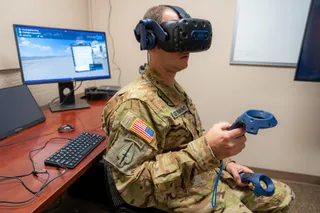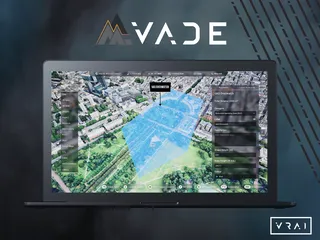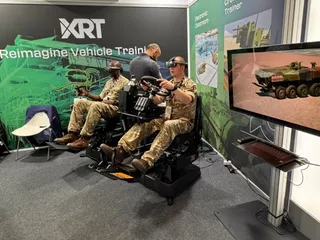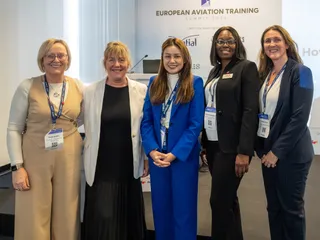How To: US Army and Mass Virtual Team Up to Deliver XR Classroom at Fort Bliss
Contact Our Team
For more information about how Halldale can add value to your marketing and promotional campaigns or to discuss event exhibitor and sponsorship opportunities, contact our team to find out more
The Americas -
holly.foster@halldale.com
Rest of World -
jeremy@halldale.com

This is another in a series of how simulation & training industry companies and their customers are teaming to expand the rigor and quality of learning (training and education) programs – a “how to” insight on the build of the system, product or service from concept through current implementation status.
The previous article in the series was a glance at an evolving program in the civil aviation training enterprise. This next piece leaps to the MS&T editorial vertical for an insight on how Mass Virtual is helping expand US Army’s digital and distributed learning capacity with the delivery of an XR-equipped classroom for the service’s aerial intelligence community at Fort Bliss, Texas.
The Requirement
Some of the fastest-paced US DoD programs of record are in the very broad intelligence community. Enter the learning requirement articulated this August for MS&T by Angel R. Acevedo, Project Support Manager (PSM), Project Director, Sensor-Aerial Intelligence (PD SAI). This recap contains key insights on the service’s early due diligence in exploring a technology solution.
The service official first recalled, “Our greatest challenge was access — soldiers couldn’t reliably get on aircraft or sensors for training, and we lacked effective ground-based training aids. We needed a way to start training soldiers much earlier in the pipeline, long before they stepped onto a plane.” Acevedo significantly pointed out the service’s early activities included “evaluating more than 20 VR companies” and discovered “most required expensive, from-scratch software development and lacked realism.” The executive continued, “What stood out about Mass Virtual’s solution was its maturity, speed of delivery, and affordability. By leveraging the Air Force’s established baseline investment, we were able to get a proven, high-fidelity system into soldiers’ hands quickly — providing training today for missions that won’t field until years from now.”
One S&T Industry Perspective
Billy Webb, Senior Business Director at Mass Virtual, provided his overarching view of the 2025-era training environment for this military service, initially observing that current training outcomes are constrained by limited resources, including insufficient access to tools, time, and qualified instructors. The retired Army CSM then offered the imperative to embrace learning technology to offset these shortfalls. “As a result, soldiers face fewer reps and sets, reduced training time, and slower progression. Without investment in scalable solutions like Extended Reality (XR), skill gaps will widen, attrition will rise, and readiness will suffer. XR bridges these gaps by delivering adaptive, repeatable scenarios that ensure consistent skill development, reduce attrition, and accelerate the production of mission-ready soldiers—even under constrained conditions. This approach not only strengthens the force but also delivers significant cost savings and serves as a true force multiplier.”
Collaboration and Other Enablers
Another major way point on the roadmap for XR classroom fielding was the early scope and breadth of collaboration among community and program stakeholders – complementing Mass Virtual and Army PD SAI’s supplier-customer relationship.
Mass Virtual working side-by-side with PD SAI ensured the solution directly addressed mission requirements and was integrated with existing training. During early development, coordination with Army Intelligence and Security Command, Army Capability Manager for Intelligence Sensors, the service’s New Systems Technology Integration Directorate, and the broader intelligence community at large helped determine where an XR classroom would provide the most value.
Webb also recalled from a technology standpoint, the Army selected the VIVE Pro 2 headset — one of the few devices cleared for military use — paired with high-performance systems from RAVE Computer to ensure smooth, realistic performance. “Mass Virtual also implemented a train-the-trainer model, preparing Army instructor pilots to teach and manage the system locally, ensuring long-term sustainment.”
Early ROIs and Other Customer Benefits
This is yet another instance of the well-planned and coordinated implementation of a learning technology (primarily XR in this case) being brought to bear to address military requirements and providing early, encouraging ROIs for the end-user.
Sam Benfer, Training Manager at Army PD SAI, first noted the system’s fidelity draws interest for soldiers to voluntarily pursue training. “When soldiers are asked if they’ll use it again, the answer is always a resounding ‘YES!’. Saving time and money are high priorities and our partnership absolutely accomplishes these in spades; but as a person with effective training as my priority, having provided an asset that soldiers are eager to use has been the biggest return of all.” The service manager added, “With a chaotic flight schedule and planes often absent from the hangar, the VAST [Virtual Aerial Systems Trainer] Classroom gives soldiers, both pilots and equipment operators, access to an ultra-realistic aircraft… 24/7, 365. That’s something we simply couldn’t do before.”
Taking a deeper dive on the technology, early Army users consistently highlight the fidelity and realism of the system, which was reported to be significantly higher than previous VR training attempts. “Some common issues in earlier systems, like motion sickness, are virtually non-existent. The structured movement controls further enhance comfort,” according to Benfer.
Further, within the first three months, 55 unique users at Fort Bliss had trained 81hours in the system — a significant number given the limited pool of eligible personnel. The XR classroom also offers a 2-D mode for those unable to tolerate immersion, ensuring training remains accessible. The system also allows operators to gain familiarity with aircraft environments before platforms are available, bridging critical training gaps.
Challenges and LLs for the Wider S&T Community
While early, attention-getting ROIs and other successes have been reported for the Fort Bliss-based XR classroom project, there are also key lessons learned to convey to industry-customer teams across high-risk community learning enterprises.
The Mass Virtual-Army team first noted as with any new technology, there were pockets of initial skepticism among users who had only experienced low-fidelity VR in the past. “Once exposed to Mass Virtual’s higher-end system, adoption, enthusiasm, and advocacy grew rapidly,” program stakeholders recalled and added, another lesson learned was the importance of having a designated classroom manager or point of contact. “In Air Force VR classrooms, this role is well-established, but at Fort Bliss it remains an area for improvement. Establishing clear ownership will help maximize usage and data capture going forward.”
And of no surprise, like many other defense programs and companion activities in civil aviation and high-risk industries, funding and scalability are ongoing hurdles. The stakeholders emphasized, “While the first classroom has generated strong demand — with other units already calling to ask how they can obtain a system — expansion depends on budget priorities.”
Down-Range View
With the program’s early successes and challenges noted, Director Webb observed word-of-mouth is spreading across the Army training community, with units beyond Fort Bliss expressing interest in accessing the capability. “The program is also being nominated for industry recognition, underscoring both its innovation and its impact,” Webb said and concluded, “Ultimately, this effort demonstrates how Army PD SAI and Mass Virtual partnered to deliver a forward-looking training solution that meets today’s needs while building toward future scalability.”
[Author’s note: An overview of the US Army XR-enabled training program for its airborne intelligence operators may be viewed at https://vimeo.com/1113922805/4f27816ea6. Source; Mass Virtual]


